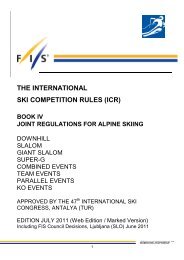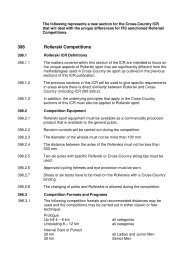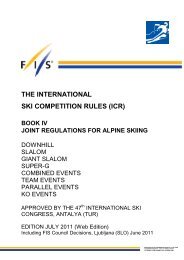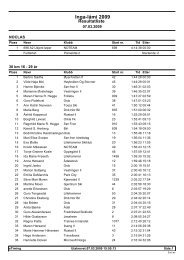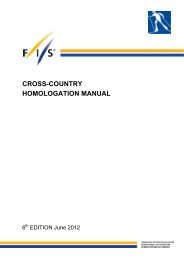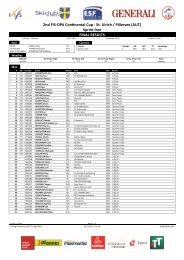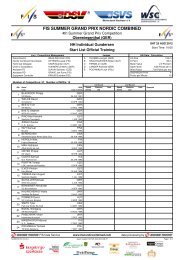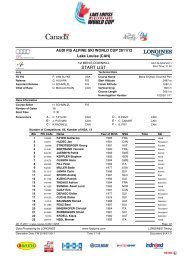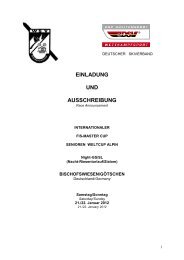Create successful ePaper yourself
Turn your PDF publications into a flip-book with our unique Google optimized e-Paper software.
PEAK 2 PEAK GONDOLA<br />
The Peak 2 Peak Gondola is a record-setting 3S (3 ropes) aerial tramway that was constructed<br />
by Doppelmayr during the summers of 2007 and 2008.This ropeway connects the Rendezvous<br />
Restaurant on Blackcomb Mountain with the Roundhouse Restaurant on Whistler Mountain in<br />
Whistler, British Columbia, Canada.<br />
The total length of this new ropeway is<br />
4.4 kilometers and the 28-passenger<br />
gondola cabins traverse the Fitzsimmons<br />
Valley in approximately eleven minutes.<br />
The highest point off the ground, in the<br />
center of the span, is 436 meters above Fitzsimmons<br />
Creek. The Peak 2 Peak Gondola<br />
will hold four new world records:<br />
● 4.4 km – longest lift of its type<br />
● 3024 kilometers – longest length of unsupported<br />
span<br />
● 436 meters – highest point above the<br />
ground for a cable system<br />
● 13.56 km – longest connected tourist<br />
ropeway system<br />
History – the big idea<br />
The genesis of the Peak 2 Peak Gondola<br />
occurred on February 17, 1997 when<br />
Hugh Smythe, President of Intrawest Resort<br />
Operation Group, and Paul Mathews,<br />
President of Ecosign Mountain Resort<br />
Planners Ltd., based in Whistler, British<br />
Columbia, were on a technical visit to<br />
Switzerland. After inspecting the new 150passenger<br />
aerial tramway from Blauherd to<br />
Rothhorn in Zermatt, they were in a helicopter<br />
on a flight towards the famed Matterhorn,<br />
and Mathews pointed out a silver<br />
thread in the sunlight which links the<br />
Trockener Steg station to the Klein Matterhorn.<br />
Mathews commented that the distance<br />
between the last tower on Mayer’s<br />
Plateau to the Klein Matterhorn was 2.7<br />
kilometers. Smythe asked the relevance of<br />
that fact and Mathews replied, “That is the<br />
same distance from the bottom of the Harmony<br />
Chair on Whistler Mountain to the<br />
bottom of the 7th Heaven Express on<br />
Blackcomb Mountain.” The big idea for<br />
the P2P was born that day.<br />
Mathews’ company, Ecosign, has been responsible<br />
for master planning at Whistler<br />
and Blackcomb since the mid 1970s. Upon<br />
returning home from Switzerland, Mathews<br />
and Smythe commenced drawing up the<br />
first plans for a link between the two<br />
mountains.<br />
With the technology available in 1997, it<br />
was possible to achieve a capacity of 1125<br />
persons per hour with a 125-passenger aerial<br />
tramway cabin or 1350 persons per hour<br />
with a 150-passenger cabin. The thought in<br />
those days was that this would just be a link<br />
for skiers and snowboarders during the winter.<br />
The initial concept was for a reversible<br />
aerial tramway to cross Fitzsimmons Valley<br />
with no intermediate support tower. The<br />
cost of about CAD $15 million dollars<br />
(1997) seemed astronomical at the time,<br />
but the concept was intriguing.<br />
Is the Peak 2 Peak a ski lift, a transportation<br />
solution or just a big WOW factor?<br />
Actually, Ecosign and Whistler/Blackcomb<br />
believe that the Peak 2 Peak Gondola is all<br />
three.<br />
A fantastic ski lift<br />
Hugh Smythe has always described<br />
Whistler and Blackcomb Mountains as two<br />
large mushrooms sitting side by side. There<br />
is the slender stalk up to a large cap on each<br />
mountain, with the stalk representing the<br />
access systems from the valley floor and the<br />
mushroom caps representing the large<br />
alpine bowls on each mountain. Both<br />
Whistler and Blackcomb have three major<br />
climatic zones, delineated by elevation: the<br />
lower mountain, from 775m up to about<br />
1250 meters, the sub-alpine one from 1250<br />
to 1900 meters, and the alpine zone rising<br />
up to 2250 meters. Blackcomb has two access<br />
systems, the Excalibur Gondola from<br />
Whistler Village (with an angle station at<br />
Base II) and the Wizard Chair from the<br />
Blackcomb Benchlands. Blackcomb has<br />
four high-alpine zones including 7th Heaven,<br />
Jersey Cream Bowl, the Horstman Glacier<br />
and the Blackcomb Glacier. The capacity<br />
of the sub-alpine and alpine zones on<br />
Blackcomb Mountain is 13,500 skiers per<br />
day. Whistler Mountain currently has three<br />
access systems including one from Whistler<br />
Creekside, at 650 meters elevation, up to<br />
the Roundhouse, at 1,835 meters, and two<br />
from Whistler Village: the Whistler Village<br />
Express Gondola and the Fitzsimmons and<br />
Garbanzo detachable quad chairlifts.<br />
Whistler has five alpine bowls: West Bowl,<br />
Whistler Bowl, Glacier Bowl, Harmony<br />
Bowl and Symphony Bowl. Whistler has a<br />
capacity of about 18,000 skiers per day in<br />
the sub-alpine and alpine zones. Hence, the<br />
reference to two large mushrooms.<br />
The mountains are so large and total journey<br />
time from Whistler Peak or Blackcomb<br />
Peak down to Whistler Village and back up<br />
the companion mountain is so long that<br />
skiers generally choose one mountain over<br />
the other on any given day. It is also very<br />
inconvenient to change from one mountain<br />
to the other in response to the conditions<br />
such as fog, blowing snow, wind or simply<br />
crowding. The Peak 2 Peak Gondola will<br />
change all of that forever! Customers will be<br />
able to change mountains at high elevation,<br />
from one mountain restaurant to the other,<br />
in just eleven minutes.<br />
A transportation solution<br />
Concurrent with the first idea for the Peak<br />
2 Peak Gondola, Ecosign was hired by the<br />
Resort Municipality of Whistler to draw up<br />
a comprehensive transportation strategy for<br />
the resort. The thinking then was that it<br />
would be necessary to build a road from<br />
Function Junction, at the entrance of the<br />
Resort Municipality of Whistler, that bypassed<br />
Whistler Creekside to move large<br />
flows of traffic directly to Whistler Village.<br />
This by-pass road, including intersections<br />
and bridges, had an estimated cost of about<br />
CAD $85 million (1997 dollars). It was also<br />
considered that Highway 99, within the<br />
Resort, would almost surely have to be<br />
widened to four lanes to accommodate the<br />
ever increasing volume of traffic. Armed<br />
with the new idea for the Peak 2 Peak,<br />
Mathews and consulting transportation engineer<br />
Reid Crowther built a model of the




